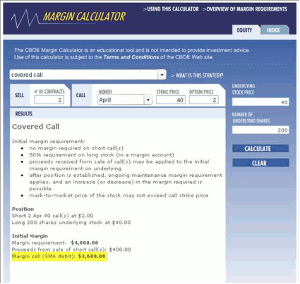Can covered call writing profits be leveraged to even higher levels using margin accounts? Absolutely, writes Alan Ellman of TheBlueCollarInvestor.com, and he shares a detailed example here.
In real estate investing, the concept of leveraged investing is well known and documented in such best-sellers as Robert G. Allen’s Nothing Down for the 2000s and Michael A. Lechter’s OPM (Other People’s Money). The idea of generating profit while using little or none of your own money down is enticing and exciting. It actually does make sense in certain scenarios. For example, when you own an investment property, you are using “OPM” as your tenant is paying off the mortgage. When it comes to the stock market, the use of options is a great example of leveraged investing. The option buyer (not us) is controlling shares of stock at a greatly reduced cost.
When we write covered calls, we are using the cash generated from the call premium sale to either reduce our cost basis or to take the profit and re-invest it, thereby compounding our profits instantly (the next trading day or T +1, in the case of options). There is another way to leverage our covered call investments and that is to trade in a margin account.
Margin Account
This is a brokerage account where the client has the ability to borrow money from the broker to purchase securities. This loan is then collateralized by the cash and securities in that specific account. Both gains and losses can be magnified via this form of leverage. If and when the value of the security drops to a certain level, the investor will be required to put additional cash in the account or sell certain securities. This is known as a margin call. You are only allowed to borrow money to buy certain securities called marginable securities. You cannot buy options on margin. However, when writing covered calls you can borrow money for the first leg of the trade, which is the purchase of the security.
Interest a Factor
When money is borrowed from our broker in a margin account, interest is charged and needs to be calculated into our results. This expense is known as the Cost to Carryand should be more than compensated for since the cost to borrow ranges between 5-9% per year and educated covered call writers should easily beat that in normal market conditions.
How Much Can I Borrow?
According to Regulation T, theSEC has set the maximum borrowing power to purchase a stock @ 50% of the lower of these two:
Current stock price
Call’s strike price
In addition to the 50% rule, the cash generated from the option sale will reduce the amount of cash required to enter the position.
Example of margin in a covered call trade:
Buy 200 x BCI @ $40 = $8,000
S-T-O 2 x $40 calls @ $2 = $400
NEXT PAGE: Details of the Strategy
|pagebreak|Next, let’s feed this information in to a margin calculator.
As you can see, the amount of cash required to invest is reduced from $8,000 to $3,600 by taking 50% of the $8,000 and then subtracting the $400 generated from the sale of the short call. Let’s assume our shares are assigned and calculate our returns with and without margin:
Cash Account:
ROO = $400/$8000 =5%, 1-month return
Margin Account:
We will assume a 9% interest charge on the $4,000 loan. This results in a 1-month debit of $30 ($4,000 x 9%/12).
ROO = $400 – $30/$4,000 = 9.3%, nearly doubling the returns from the cash account. Notice that I didn’t deduct the $400 premium from the cost basis ($4,000) because in the BCI system we stress taking the profit and re-investing it and thereby compounding our money instantaneously. Either way is correct as it is simply a different philosophical approach to the strategy.
Maintenance Margin
Once a stock has been purchased on margin, the Financial Industry Regulatory Authority (FINRA) requires that you must maintain a minimum amount of equity in the margin account.
Equity = Share Value – amount borrowed
This minimum amount is set @ 25% and is referred to as the maintenance requirement. Many brokerages choose to have requirements between 30-40% but it cannot be less than 25%.
Maintenance Example:
Buy 200 x BCI @ $40 = $8,000
Borrow $4000 in a margin account
Market value of shares drop to $5,000
Equity falls to $5000 – $4,000 = $1,000
A 25% maintenance requirement would be $5,000 x 25% = $1,250, leaving a shortfall of $250 ($1,250 – $1,000)
Had the maintenance requirement been 40% of $5,000 or $2,000, the shortfall would be $1000.
A shortfall will trigger a margin call where the investor would be required to add cash to the account or sell stocks. It is possible that your broker can take it upon himself to sell some of your shares without notifying you with a margin call.
Minimum Margin vs. Initial Margin
Minimum margin is FINRA’s requirement that we deposit at least $2,000 or 100% of the purchase price, whichever is less. Some firms may require more.
Initial margin is set forth by Regulation T of the Federal Reserve Board and currently allows up to 50% of the purchase price of marginable securities.
Disadvantages of Margin Accounts
You may have to deposit additional cash or securities in your account on short notice to cover market losses.
Your brokerage may sell some of your shares without consulting with you to pay back the loan.
You may be forced to sell some of your securities to compensate for falling share price.
You can lose more money than you invested as risk is enhanced.
Conclusion
Margin accounts are a form of leverage, which can magnify investment results dramatically in both directions. I would only advise the use of margin accounts when writing covered calls for experienced, savvy investors with a successful track record.






















